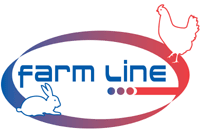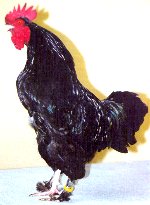

| Sponsors partenaires du MCF, informations et conditions par mail : CONTACT | |||||||
 |
|
 |
|||||
Photos sous licence Creative Commons
type http://creativecommons.org/licenses/by-sa/3.0/deed.fr
CC by sa
The Black
variety
|
|
|
|
|
 |
This Marans variety, introduced into the standard in 1949 is particularly rare today. It can also be considered to be quasi-extincted. No testimony explains its birth and for some people it remains enigmatic. The pure subjects which still exist are extremely precious for the breed and they all would have to help the composition of founders to disclove. |
Photos sous licence Creative Commons
type http://creativecommons.org/licenses/by-sa/3.0/deed.fr
CC by sa
![]()
| Nothing that the plain black variety
appears on the very top of the dominance hierarchy (in
the different color families) is enough to understand the
level of difficulty which its regeneration constitutes in
case of complete extinction of the breeding stock.
In the color description of the standard, the plain-black Marans is one the less described variety. We require a wholly black plumage for the cock and the hen, and it must have no white or fawn colored feathers which are the flaws of this color. There is no requirement of a "scarab-green" lister on the plumage as it is the case for other breeds such as the "Gauloise", "Langshan" or the "Australorp". The "plain"-Black Marans as moreover the Brown-red can be made up of a least melanin quantity (black pigments on the skin, the beak, the tails, the tarsus and the down) than the other breeds such as for example the Langshan which has contributed yet to its final composition in the 1890s, but by bringing to it other characteristics. The orangery gray eyes is so much less easy to select fot the plain-Black, Silver-Black and Brown-red Marans than for all other breeds. If the selection is sufficiently rigorous by the elimination of these flaws as well as by the "white stony" plumage (pi/pi genes) we manage without too many difficulties to obtain a founder after some generations without damnig white feathers and to maintain it with this quality without too many difficulties. |
An optimum level of intensity of the
black pigments must be researched and maintained at a
more or less constant level.
The orangery-red eyes correspond to the Marans type of origin and constitute just as the feathered tarsus and above all as the "extra reddish-brown egg" one of the fundamental guarantee of original jurity of the breed. Some
farmers have just toward criticals about the standard,
asserting that only the black-eyed hens laid extra-reddish-brown
eggs. To go back to the plain-Black Marans farming all confusion must absolutely be avoided with the hens of the Brown-red variety and the Birchen variety. The farmers wellknow that in some Brown-red or Birchen Marans founders, it is usual to obtain wholly black hens when the hackle "coppery" or "silver" color has totally shaded off by an excess of badly controlled black. If these black hens are not to be systematically rejected as work subject for the Brown-red variety,, it is of course forbidden to consider them as plain-Black variety hens. Even in the case when these two black Brown-red hens are used with a real plain-black cock, it is impossible to react the expected result of the composition of a pure Plain-Black founder. Indeed, the coppery shades of the plumage can immediately disappear (recessive) and her the black hens which have been obtained afterwards the visual control of their genetic purety as black or coppery-black will prove to be pretty difficult. Only the genotype allows, if it is appropriate to command an hereditary with 100% of pure subjects, cocks and hens of the Plain-Black variety. |
|
It is difficulut and above all very clumsy consequently to use some Brown-red subjects in the crossings with only one plain-black subject to regenerate a whole plain-black founder because the"coppery" gene (ER/ER) is often visually expressed in a risky and capricious way in the hens. On the other hand, the "cuckoo" characteristic (B) was dominating; it will be systematically visible in the plumage if it is present, even in small dose in the genotype. So it is more simple, as we saw it previously, to notice its whole genetic disappearence for the "plain-black" genotype (E/E) we want to recreate. The
numerous existing Silver-Cuckoo Marans founders can be
turned to account to reconstituate more easily a plain-Black
founder or to regenerate them while they are still
existing. In other words,
See also the Marans official
standard: Black
Variety |
|
THE OFFICIAL VARIETIES OF THE CURRENT STANDARD
|
Silver-cuckoo Variety |
|
OTHER VARIETIES NOT APPROVED YET